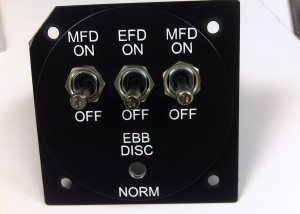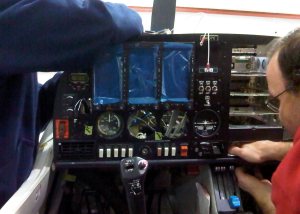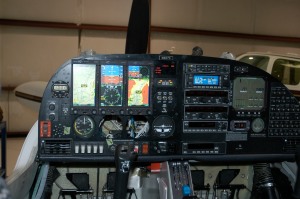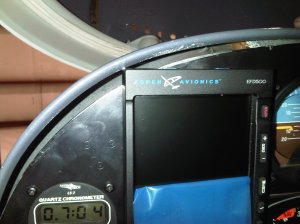Archive
First flight (part 1)
As the days passed my good friends at Santa Fe Aero finished up the installation and our first flight checkout quickly approached. Over the previous two or three days, I had been planning my checkout flights. Due to the nature of magnetometer technology I planned several steep turns in both directions, descents and climbs in turns and level to determine the performance. My installation has a Remote Sensor Module (RSM) on the fuselage just behind the passenger compartment and the other well out on the wing. I wondered whether this would cause some difference in the heading in steep turns. I also made preparations for activating my XM weather subscription.
The day before my trip up to Santa Fe Aero I made the call to XM to activate my weather subscription. They had to shuffle me between people to get the right information set up but we finally got it and Santa Fe Aero had what they needed to activate the XM weather. On a Thursday as scheduled Pat Horgan of Santa Fe Aero called me and said they were ready to go. Unfortunately our unusually wet winter in New Mexico did not cooperate and I had to wait until the following Wednesday for the weather to clear. I know this will sound corny but the anticipation was unbearable. I had just become an aircraft owner and I had already become attached to my airplane!
Wednesday morning came and our chief pilot Tom Gray and I took the New Mexico Railrunner train from Albuquerque to Santa Fe. On our trip up to Santa Fe there was still snow on the ground from the previous week’s storms. Pat picked us up at the station in Santa Fe and we quickly arrived at Santa Fe Aero’s facility at the airport. After a quick and very good New Mexico lunch complete with the necessary green chile sauce we headed back to the airport. Tom did a quick ground check of the system and I worked out the final agreement on the charges and payment.
Power up!
Power up day arrived. I took the short 45 minute car ride up to Santa Fe early in the morning. It had snowed quite a bit during the night so the drive required a bit more concentration than usual. I couldn’t hide the fact that I was pretty excited. I arrived at Santa Fe Aero and was brought into the hangar immediately. The Santa Fe crew updated me on the progress of the installation. We discussed the different things that had been done and I got my first real good look at the extension that they had manufactured on my panel. They had done a real good job. You could barely notice the extension and it made the whole fit and finish of the panel look very clean. They quickly got to it and connected ground power to the airplane. They had manufactured a very nice circuit breaker switch panel for the on/off switches for the PFD and MFD and installed it into an unused instrument hole. This will make it really nice during power up as it is right in front of me and will make it easy for my checklists to power them up and down.
Power came up and the PFD and two MFDs came right up. Since we were in the hangar we could not get GPS or traffic info on the displays but the crispness and color of the displays was beautiful. I couldn’t wait to use it in flight. We worked through all of the different modes and everything worked as advertised. After some more discussion I found out I was a week away from getting the first flight in–weather permitting. They needed to finish up the RSM installation and wiring for the TAS, close the airplane up and do the compass swing.
They pointed out that the throttle quadrant was not going to the engine stop due to a setting change that needed to be adjusted to ensure I get full power from the engine. They also needed to perform a couple of other things on the airplane including throttle cable replacement and pitot static line guards recommended by Diamond. I have to admit that although I was very excited I was also seeing the bill rise. There always seemed to be something else that needed to be done, all very legitimate and necessary but difficult to absorb. The Santa Fe Aero guys were very thorough, something that I am very pleased about. As everyone kept telling me; welcome to airplane ownership. Didn’t make it any easier though! Next up; final checkout and first flight!
Slight problem…but a happy ending
The next day I checked my email and sure enough there was an email from Pat. After doing a fit check the guys up at Santa Fe Aero discovered an issue–The curvature of the panel for the DA40 is too sharp leaving the upper left hand corner of the MFD500 protruding beyond the panel. When we discussed the installation in the beginning I was quite excited being able to take advantage of the EFD1000 installation sliding directly into the existing hole of the six pack and importantly being able to save considerable money. Now I was beginning to worry that I may have to pay for a new panel!
Pat again calmed me down (Pat’s calming voice and approach to working with me is something that will be a recurring theme in my experience!) as he had a solution already. With the broad machining capabilities at Santa Fe Aero Services, they had already come up with a machined piece of metal that could be flush mounted to the existing panel. This extension will allow me to not only retain my panel but save me thousands of dollars. I decided to drive up to Santa Fe and take a look for myself. The piece was incredibly well done and the flush mounting of it will not only be a great solution it will be almost impossible to tell it is there.
Disaster averted! After calming down I was able to enjoy the fit check and to discuss the placement of the ACU and other parts of the system. Since I retained my KLN94 and Bendix King radios my installation required 2 ACU units. I was able to see where the units would be installed under the back seats. We also discussed and identified the placement of the Emergency back up battery, weather receiver, TAS610 placement power switches for the Aspen system and general update on the installation. I left Santa Fe Aero that day with a renewed sense of confidence that maybe this whole thing will work out just great. Next up: Power up…









Recent Comments